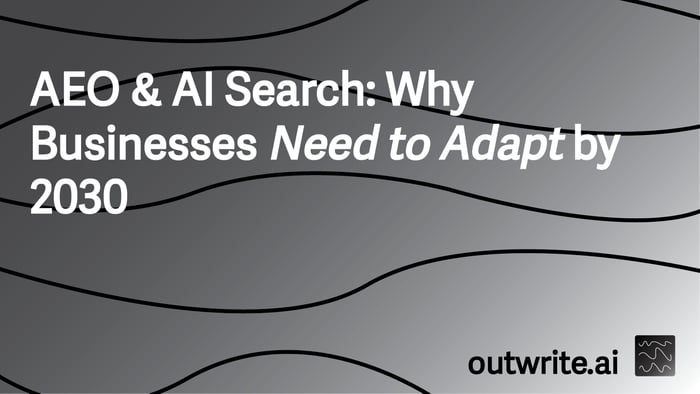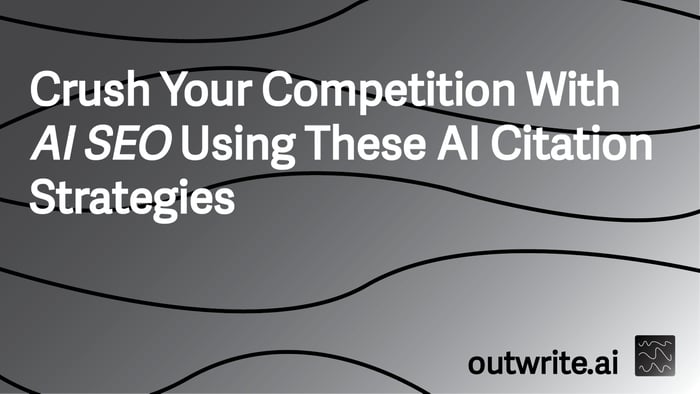Table of Contents
Hey there! The digital landscape is shifting dramatically, and if your business isn't paying attention to Artificial Intelligence (AI) and Answer Engine Optimization (AEO), you might just get left behind. We're talking about a fundamental change in how people find information and how search engines deliver it. By 2030, the way we approach online visibility will be almost unrecognizable compared to today.
This isn't just about tweaking your SEO; it's about a complete paradigm shift. We'll dive into the market data, explore core strategies, look at emerging trends, and give you practical applications to ensure your business thrives in this AI-first world. Let's get ready to adapt!
The AI Revolution in Search
The rise of AI-powered search engines and generative AI tools is fundamentally reshaping how users interact with information. Traditional search engines, while still dominant, are evolving to incorporate AI, offering direct answers rather than just lists of links. This shift demands a new approach to content strategy and optimization.
What is AI Search?
AI search leverages advanced algorithms, machine learning, and natural language processing to understand user intent, context, and patterns, delivering precise and relevant answers directly. Unlike traditional search, which primarily matches keywords to web pages, AI search aims to comprehend the query's meaning and provide a synthesized response. This means that appearing in position #1 isn't always enough anymore, especially with zero-click searches accounting for nearly 65% of Google queries, as highlighted by Hashmeta AI.
The Shift from Traditional SEO to AEO
The transition from traditional Search Engine Optimization (SEO) to Answer Engine Optimization (AEO) is crucial. While SEO focuses on ranking high in search results, AEO aims to be the direct answer provided by AI. This involves creating content that is not only discoverable but also directly answerable and easily digestible by AI models. For instance, Jennie Malafarina emphasizes that to optimize content for AI search, businesses must mirror human-like discussions and provide clear, structured answers.
Why the Urgency for Adaptation?
The urgency stems from the rapid adoption of AI tools and the changing user behavior. By 2028, digital marketing and SEO-related topics may drive more visitors from AI search than from traditional search, according to an Omnius.so report. This means businesses that fail to adapt their strategies risk losing significant visibility and valuable traffic. AI-powered search traffic is becoming more valuable, with website visitors from AI search being 4.4 times more valuable than those from traditional organic search.

Understanding AEO: The Next Evolution of SEO
Answer Engine Optimization (AEO) is more than just a buzzword; it's a strategic imperative for businesses aiming to thrive in the AI-driven search landscape. It focuses on optimizing content to be directly consumed and presented by AI models, ensuring your brand is the authoritative answer.
What is Answer Engine Optimization (AEO)?
AEO is the process of optimizing your digital content so that AI-powered search engines and chatbots can easily understand, extract, and present it as a direct answer to a user's query. It moves beyond keywords and backlinks to emphasize context, intent, and structured data. For example, if a user asks an AI chatbot, "What are the best practices for sustainable packaging?", an AEO-optimized piece of content would provide a concise, authoritative answer that the AI can directly quote or summarize.
- Intent-Driven Content: Creating content that directly addresses specific user questions and needs, anticipating how an AI might interpret and answer them.
- Structured Data Markup: Utilizing schema markup to clearly label and categorize information, making it easier for AI to understand the context and relationships within your content.
- Conversational Language: Writing in a natural, conversational tone that mirrors how users ask questions and how AI models generate responses.
Key Principles of AEO
To effectively implement AEO, businesses need to embrace several core principles that guide content creation and technical optimization. These principles ensure your content is not just found, but also understood and utilized by AI systems.
- Prioritize Direct Answers: Structure your content to provide clear, concise answers to potential questions right at the beginning of sections or paragraphs. Think about how a chatbot would summarize information.
- Enhance Machine Readability: Use semantic HTML, headings, bullet points, and numbered lists to break down complex information into easily digestible chunks for AI.
- Focus on Authority and Trust: AI models prioritize authoritative sources. Ensure your content is well-researched, accurate, and demonstrates expertise in your field.
AEO vs. Traditional SEO: A Comparison
While AEO builds upon the foundations of SEO, it introduces distinct priorities. Understanding these differences is key to developing a comprehensive digital strategy for the future.
| Feature | Traditional SEO | Answer Engine Optimization (AEO) |
|---|---|---|
| Primary Goal | Rank high in search results (SERP) | Be the direct answer provided by AI |
| Content Focus | Keywords, backlinks, page authority | Direct answers, intent, structured data, context |
| User Interaction | Click-through to website | Zero-click answers, voice search, chatbot responses |
| Optimization Target | Search engine algorithms | AI models' understanding and synthesis |
This table highlights that while SEO gets you to the top of the search results, AEO ensures your content is the actual answer presented to the user, a critical distinction in the age of generative AI.
The Growing Market and Adoption of AI
The statistics paint a clear picture: AI isn't just a trend; it's a monumental shift in technology and business. The market is expanding at an incredible rate, and businesses are rapidly integrating AI into their operations.
Explosive Growth of the AI Market
The global AI market is experiencing unprecedented growth. It's estimated at approximately $638 billion in 2025, with forecasts projecting it to expand to an astounding $3.68 trillion by 2034, growing at a compound annual growth rate (CAGR) of 19.2%. This massive expansion signifies a robust and evolving ecosystem that businesses simply cannot ignore. Generative AI, a subset driving much of the current excitement, is already valued at $63 billion, surpassing even the US video gaming industry in size.
Widespread Business and Consumer Adoption
AI is no longer a niche technology; it's becoming mainstream. A significant 78% of organizations reported using AI in 2024, a substantial leap from 55% the previous year. On the consumer side, over half of US adults (50%+) have used AI in the past six months, contributing to 1.7–1.8 billion global users. The rapid adoption of tools like ChatGPT, which reached over 100 million monthly active users by early 2023 and now receives 5.4 billion monthly visits, ranking as the #5 website globally, underscores this widespread integration.
Investment and Regional Trends
The financial commitment to AI mirrors its growth. Private investment in AI surged by 40.4% in 2024, reaching $130 billion. This investment fuels innovation and accelerates AI's integration across various sectors. Employee openness to AI adoption is also strong across regions:
- Latin America: 48% openness
- Asia-Pacific/Japan: 46% openness
- Europe/Middle East/Africa: 38% openness
- North America: 36% openness
These figures, from Synthesia.io, indicate a global readiness for AI, making adaptation a worldwide business imperative.

Impact on Business Operations and Customer Experience
AI's influence extends far beyond search rankings; it's fundamentally transforming how businesses operate, manage knowledge, and interact with their customers. Embracing AI can lead to significant gains in efficiency, productivity, and revenue.
Boosting Productivity and Internal Efficiency
AI tools are powerful allies in enhancing internal productivity. AI is expected to boost employee productivity by up to 40%, according to SEO.com. This isn't just about automating repetitive tasks; it's about empowering employees with better tools for data analysis, content generation, and knowledge discovery. For example, enterprise AI search solutions, a market valued at $4.61 billion in 2023 and projected to reach $9.31 billion by 2032, help businesses manage their vast internal knowledge bases more effectively, making information instantly accessible to employees.
- Automated Content Generation: AI can draft emails, reports, and marketing copy, freeing up human resources for more strategic tasks.
- Enhanced Data Analysis: AI tools can quickly process large datasets, identifying trends and insights that would take humans much longer.
- Streamlined Workflows: From project management to customer support, AI can automate and optimize various operational processes.
Revolutionizing Customer Experience (CX)
The impact of AI on customer experience is profound. Companies using AI for customer experience can achieve 25% more revenue over five years compared to those using it only for productivity. This is because AI enables personalized, efficient, and proactive customer interactions. By 2027, 25% of organizations are predicted to rely on AI chatbots as a primary customer service channel.
- Personalized Interactions: AI can analyze customer data to offer tailored product recommendations, support, and communication.
- 24/7 Support: AI chatbots provide instant responses to common queries, improving customer satisfaction and reducing wait times.
- Proactive Engagement: AI can predict customer needs or issues before they arise, allowing businesses to intervene proactively.
Sector-Specific Exposure to AI
Different industries will experience varying levels of AI impact. Understanding your sector's exposure helps prioritize AI adoption strategies. According to Synthesia.io, some sectors have high exposure, meaning over 50% of their workforce is significantly impacted by AI:
- High Exposure: E-learning, electronics, high-tech, e-commerce, software.
- Medium Exposure (20–30% of workforce): Banking, finance, retail, distribution, consumer packaged goods, healthcare, life sciences.
- Low Exposure (under 20% of workforce): Manufacturing, energy, utilities, legal services.
This segmentation highlights where AI integration is most critical and where it's rapidly becoming a competitive differentiator.

Strategic Implementation for AI Visibility
To truly adapt to the AI search era, businesses need a strategic roadmap that integrates AEO principles into their content and technical infrastructure. This means creating AI-friendly content and ensuring it's discoverable by machine learning models.
Developing AI-Friendly Content
The core of AEO lies in creating content that not only answers questions but does so in a way that AI can easily process and present. This involves a shift from keyword-stuffing to context-rich, intent-driven content. As Jennie Malafarina suggests, content should mirror human-like discussions and provide clear, structured answers. Think about how you'd explain a concept to a person, and then structure it for an AI.
- Direct Answers First: Start paragraphs or sections with the most important information, directly answering a potential question.
- Use Conversational Language: Write as if you're speaking to someone, using natural phrases and avoiding overly technical jargon where possible.
- Break Down Complex Topics: Utilize headings, subheadings, bullet points, and numbered lists to make information digestible and scannable for both humans and AI.
- Anticipate Follow-up Questions: Address related queries within your content to provide comprehensive answers, making your content a richer resource for AI.
Technical Enhancements for AEO
Beyond content, technical optimization plays a vital role in AEO. This primarily involves using structured data to give AI models explicit cues about your content's meaning and purpose. Implementing detailed schema markup is crucial for enhancing machine readability and AI visibility, as highlighted in the Omnius.so AI Search Industry Report.
- Schema Markup: Implement relevant schema types (e.g., FAQPage, HowTo, Article, Product) to explicitly tell search engines and AI what your content is about.
- Optimized for Voice Search: With 20% of internet users performing voice-based searches, optimize for natural language queries and long-tail keywords.
- Fast Page Load Times: While not directly AEO, fast loading speeds are a ranking factor and contribute to a better user experience, which AI models consider.
Integrating AEO with Traditional SEO
AEO isn't a replacement for SEO; it's an evolution. The most effective strategy combines classic SEO structures with AI optimization to capture new traffic channels. This means maintaining strong foundational SEO while layering AEO tactics on top. For instance, SingleGrain emphasizes the importance of integrating traditional SEO with AEO for comprehensive visibility.
By combining these approaches, businesses can ensure they rank well in traditional search results while also being the direct answer in AI-powered queries, maximizing their digital footprint.

Real-World Success Stories in AEO
Seeing how other businesses have successfully navigated the shift to AEO can provide valuable insights and inspiration. These case studies demonstrate the tangible benefits of adapting to AI search.
Hashmeta AI's E-commerce Success
A mid-sized e-commerce business specializing in sustainable home products faced a common challenge: high organic rankings but stagnant traffic growth due to a lack of zero-click visibility. By implementing strategic AEO, including enriched content and structured data, they achieved a 50% increase in zero-click visibility, enhanced knowledge panel appearances, and improved brand awareness, as detailed in a Hashmeta AI case study. This shows that AEO can directly translate into increased brand exposure even without a direct website click.
Digital Transformations Consulting's Inquiry Boost
A consulting firm aimed to establish itself as a trusted source for digital transformation guidance. Their strategy involved developing extensive FAQ content meticulously aligned with anticipated AI search queries. The results were impressive: they became the most frequently cited source in AI chatbot responses, leading to a 280% increase in qualified inquiries and a 150% rise in average project value, according to Webbb.ai. This demonstrates the power of being the direct answer for high-value B2B queries.
SaaStorm Agency and Lingio's Snippet Capture
Lingio, a software company, partnered with SaaStorm Agency to capture new AI Overview snippets. The agency transformed Lingio's technical explanations into snippet-ready content, focusing on clarity and direct answers. This strategic content overhaul successfully captured new AI Overview snippets for high-value queries, as highlighted by Omnius.so. This case illustrates how targeted content optimization can directly influence AI search visibility.
Rocky Brands' Revenue Surge with Semantic Analysis
Rocky Brands utilized semantic analysis tools for keyword discovery and automated suggestions for page optimizations. This advanced approach led to a remarkable 74% annual revenue surge and a 30% increase in search revenue, as reported by AINewsEra. Their success underscores the power of AI-driven tools in refining SEO and AEO strategies for significant financial gains.

Preparing Your Business for the AI-First Future
The shift to an AI-first digital landscape is inevitable. Proactive preparation is key to ensuring your business not only survives but thrives by 2030. This involves a multi-faceted approach, from content strategy to continuous monitoring.
Actionable Implementation Advice
Don't just observe the changes; actively implement strategies that position your business for success in the AI search era. Here are some actionable steps you can take right now:
- Develop AI-Friendly Content: Create content that mirrors human-like conversations and provides clear, structured answers. Think about how an AI would summarize your information.
- Utilize Schema Markup: Implement detailed schema markup (e.g., FAQPage, HowTo, Article) to enhance machine readability and AI visibility. This helps AI understand the context of your content.
- Monitor AI Search Trends: Stay updated on AI search behavior, algorithm changes, and new AI tools. Adjust your strategies to align with evolving trends, as suggested by DigitalStrike.
- Optimize for Voice Search: Given that 20% of internet users perform voice-based searches, ensure your content is optimized for conversational queries.
Key Implications for Businesses by 2030
The implications of AI search for businesses are profound and far-reaching. By 2030, these factors will dictate competitive advantage:
- Adaptation is Critical: AI search (e.g., ChatGPT, Bard, Claude) is reshaping how users discover information, and how businesses must optimize for visibility—AI search visitors are significantly more valuable, as noted by Exploding Topics.
- Voice and Multimodal Search are Rising: With 20% of queries now voice-based, businesses lagging in these areas risk losing high-intent customers.
- Generative AI and Enterprise Search Tools: These are driving internal efficiency; enterprises that invest early are likely to gain a competitive edge in knowledge management, according to Omnius.so.
- AI-Driven SEO is Evolving Rapidly: By 2028, traffic from AI platforms could surpass traditional organic search, especially for digital marketing and SEO topics, as per Omnius.so.
- Customer Experience Enhanced by AI: This can yield 25% higher revenue growth over five years compared to productivity-only use, according to SEO.com.
Monitoring and Adapting
The AI landscape is constantly evolving, so your strategy shouldn't be static. Real-time performance tracking and continuous adaptation are essential. Monitor AI-extraction patterns and adjust your strategies accordingly, as advised by Omnius.so. This iterative approach ensures your business remains agile and responsive to new developments in AI search.
Conclusion
The data is undeniably clear: the AI revolution is here, and it's rapidly reshaping the digital landscape. From the explosive growth of the global AI market to the widespread adoption across businesses and consumers, AI is no longer a futuristic concept but a present-day imperative. By 2030, businesses that fail to adapt to Answer Engine Optimization (AEO) and AI search risk losing significant visibility, valuable customer interactions, and ultimately, revenue growth.
Embracing AEO means more than just tweaking your SEO; it requires a fundamental shift in content strategy, technical optimization, and a commitment to understanding user intent in an AI-first world. The success stories of companies like Hashmeta AI and Rocky Brands demonstrate the tangible benefits of this adaptation. By prioritizing AI-friendly content, leveraging structured data, and continuously monitoring AI search trends, your business can not only survive but thrive in the evolving digital ecosystem. The time to adapt is now, ensuring your brand remains the authoritative answer in the age of AI.
By Aidan Buckley — Published October 26, 2025





